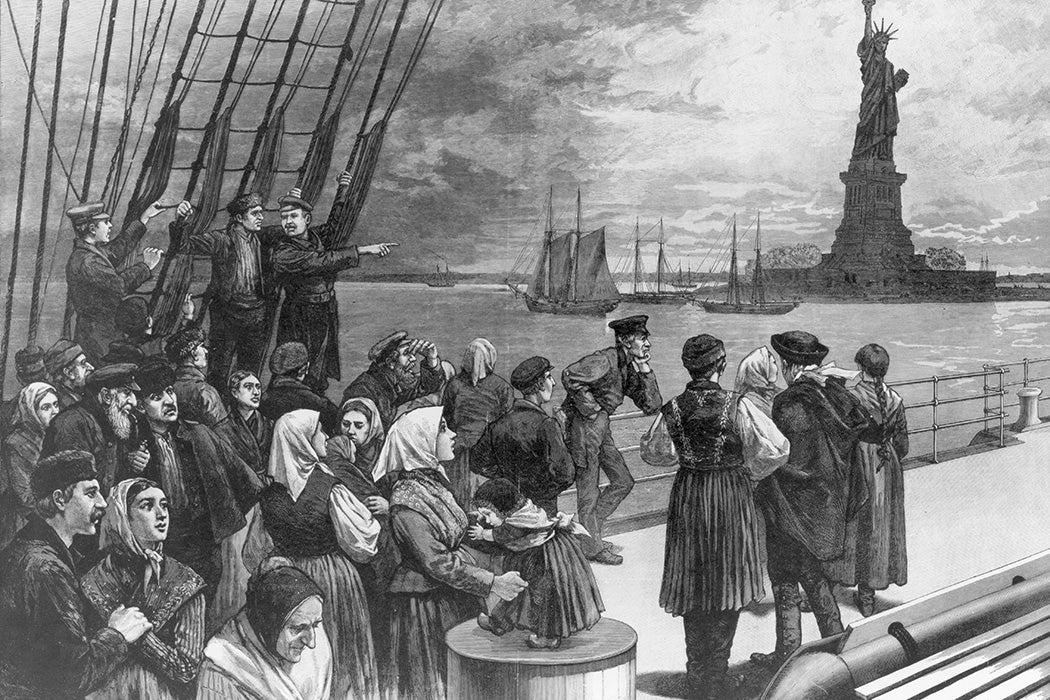Until the Civil War, the admission of foreigners into the United States was a local affair. So was the regulation of the movement of both free and enslaved Black people. Such matters were considered to fall under the police powers of individual states. There was no national immigration policy. Historians in a special issue of the Journal of Civil War Era explore how all this changed and led to Henderson v. Mayor of New York (1876), in which the Supreme Court gave its imprimatur to federal control over immigration policy.
Historian Michael Schoeppner sets the stage. He argues that the many state and local laws that regulated the mobility of free Black people in the antebellum period were a kind of racial immigration control. America’s first “illegal immigrants” were Black.
“Free Black people faced border regulation and migration bans across the antebellum United States,” he writes. Laws restricting their movement were so ubiquitous that
they approached a national immigration regime […] And while the antebellum Supreme Court struck down some state-level immigration regulations of transatlantic European migrants in 1849, it never heard a case on Black exclusion laws, and state supreme courts uniformly upheld the laws until Reconstruction.
Even free states had such laws: Illinois’s Act to Prevent the Immigration of Free Negroes Into This State was enacted in 1853, a few years after Illinois’s constitution ended slavery in the state. The act would be upheld by the state’s highest court in 1863, in the midst of the Civil War. The plaintiff in the case, named Nelson, was condemned to forced labor for entering Illinois by crossing the Mississippi River from Missouri.
The enslaved had, by legal definition, no freedom of movement. Pro-slavers like SCOTUS Chief Justice Roger B. Taney opposed federal control of immigration precisely because they thought such control would supersede local regulation of Black people’s movement, including the internal slave trade itself.
The Civil War’s dismemberment of slavery meant that antislavery became the dominant ideology shaping post-war immigration policy. This played out in ironic ways, as historian Kevin Kenny shows by highlighting two federal laws that paved the way to immigration control by federal authority.
In 1862, the US prohibited American involvement in the “Coolie Trade,” meaning the transportation of Chinese contract workers. The argument was that coolies, as they were typically called, were akin to slaves and that shipping them was a transpacific variation of the Atlantic slave trade. The law did not, however, ban the importation of Chinese workers into the country, where they were still defined as free workers. But the law did inspire those working against Chinese immigration to the US to argue that all coolies should be excluded on antislavery grounds. These forces got their wish with the Chinese Exclusion Act of 1882—the first federal law preventing a specific people from immigrating to the US.
Kenny also draws attention to the 1864 Act to Encourage Immigration, which sanctioned the importation of European contract laborers. But opposition to contract labor, again on antislavery grounds, led to the banning of all such contracts with the Foran Act of 1885. Kenny writes that Chinese laborers came to be seen as inherently unfree, while European laborers, “liberated from the shackles of contract, emerged as America’s archetypal immigrants.”
With no overarching antebellum immigration policy, states made their own rules. This meant that state lawmakers were the focus of political pressure from the shipping industry. The migrant passenger trade was big business and entrepôts like New York were lobbied hard by the industry.
Weekly Newsletter
Historian Katherine Carper details the migration industry’s decades-long effort to influence state immigration laws, particularly in abolishing state passenger fees, which made the business less profitable. They succeeded in capturing control of New York’s immigration process before the Civil War. Then the war reduced the industry’s power. After the war, they tried to reassert themselves. But now a multi-state lobbying campaign seemed too complicated; they pushed to have immigration become a federal issue, which would mean they’d only have to exert their influence in one place, Washington, DC. The very New York law the industry had helped create in the first place now became the industry’s target. The Supreme Court agreed with them, overturning New York’s immigration rules during the 1875–1876 term and transferring immigration control to the national government.
As these historians detail, this period set a template for what was to follow: controlling population movement based on race; defining desirable/undesirable classes of migrants and types of labor; and making policies that aligned with powerful interests profiting off of migrants.
Support JSTOR Daily! Join our membership program on Patreon today.







